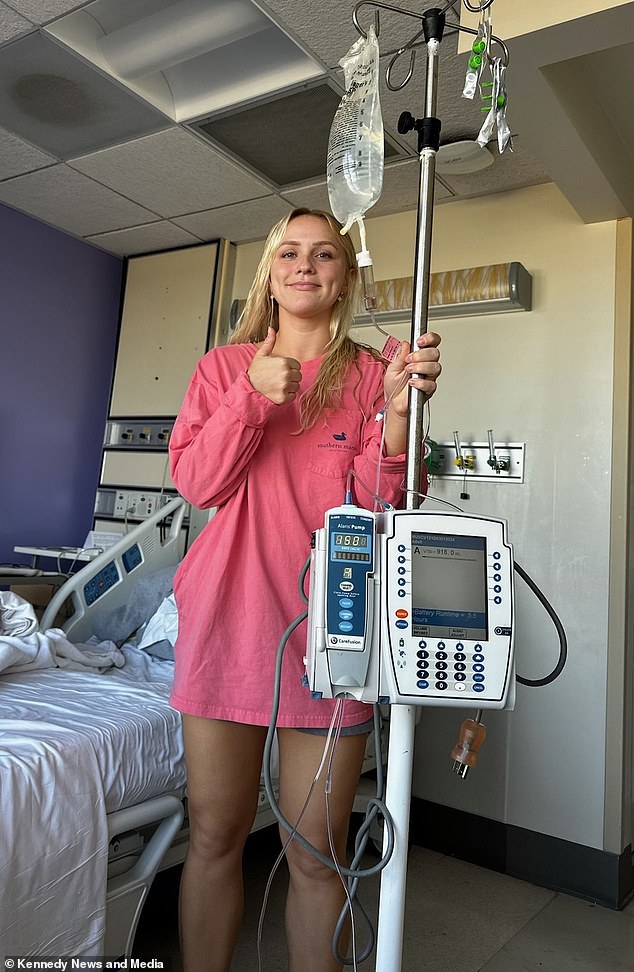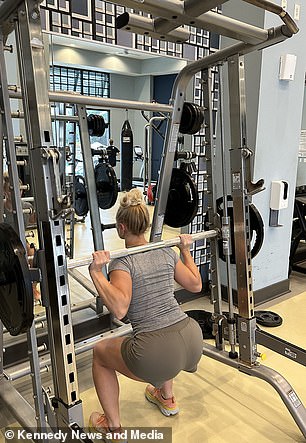A South Carolina woman claims her biceps on both arms “exploded” after attempting a CrossFit challenge.
Jessica Johnson, 25, had started training for the intense Murph Challenge last month, which involves completing two one-mile runs and hundreds of push-ups, pull-ups and squats.
Her arms were ‘super sore’ and swollen after completing 50 pull-ups in preparation for the challenge, but she put it down to how hard she had worked them.
However, after four days, the health worker said she felt “like the Hulk” because her arms swelled up and she lost feeling in her hands.
Her muscles had begun to deteriorate and die due to a condition called rhabdomyolysis. This caused large amounts of chemicals, such as potassium, to leak into her bloodstream and attack her kidneys and liver, which can cause potentially fatal organ failure if left untreated.
Jessica Johnson, 25, had done 50 pull-ups as part of the intense Murph challenge when her arm muscles “exploded”

Ms Johnson’s arms became so swollen (pictured) that she had trouble brushing her teeth or showering. She spent four days in hospital receiving intravenous fluids and electrolytes.
Additionally, she noticed that her urine had become much darker than normal, appearing almost orange due to excess toxins and waste.
“I was definitely in shock and didn’t know this could happen,” Johnson said in a TikTok video. “Being hospitalized for rhabdomyolysis was definitely not on my 2024 bingo list.”
The Murph Challenge is an exercise program that involves two one-mile runs, 100 pull-ups, 200 push-ups, and 300 air squats. This typically takes between 40 minutes and an hour.
Ms. Johnson had only started the challenge the week after her injury, first focusing on 10 sets of five pull-ups.
“I came out of the gym pretty tired. I thought, ‘God, these are going to hurt a lot tomorrow.’ It’s been a while since I’ve trained my arms like that,” she said.
When he woke up the next morning, he noticed that his arms were so swollen that he had trouble brushing his teeth or showering.
“I thought, ‘Oh my God, my arms don’t want to work properly,'” she said. “I couldn’t fully stretch them out.”
“There was visible swelling. He looked like the Hulk. Everyone was like, ‘We thought you were super-muscled or something.'”
Meanwhile, the strain had caused the fibers in Ms. Johnson’s muscles, which form muscle tissue and control function, to stretch and weaken.
Without this structure, the fibers began to unravel, causing the muscles to break down and begin to die.
Even though she stayed hydrated throughout the day, “I didn’t urinate much during the day. I thought that was a little weird,” Johnson said.
‘I was a little nervous because I didn’t know what was going on.’
Four days after training, Ms. Johnson rushed to her local urgent care center, who immediately sent her to the emergency room and confirmed rhabdomyolysis.
“The doctors were pretty sure it was the pull-ups,” she said. “They almost had to open my arms to release the tension.”

Ms Johnson, pictured at the gym, initially thought nothing of her swollen muscles but doctors warned she was suffering from kidney and liver damage.


Ms Johnson said she no longer plans to complete the Murph challenge and will instead focus on less intense exercises such as pilates. Her doctors have advised her to ease back into exercise slowly.
Fortunately, doctors were able to stabilize Ms. Johnson’s condition with intravenous fluids and electrolytes over the course of four days.
Although rhabdomyolysis manifests with innocent symptoms, such as tender and swollen muscles, it can pose a danger to organs such as the kidneys.
As muscles deteriorate, they release large amounts of chemicals such as potassium, phosphate, and creatinine into the bloodstream.
Normally, the kidneys filter them into urine, but in large amounts, the kidneys have a hard time keeping up.
This causes these chemicals to build up, resulting in kidney damage and failure.
This could explain why Mrs. Johnson’s urine turned orange.
“What they were most concerned about was my organs. In rhabdomyolysis, cells basically explode in the muscles. The muscles burst,” he said.
Ms Johnson suffered damage to her kidneys and liver, although she made a full recovery and was discharged from hospital four days after her admission.
Although the condition seems extreme, rhabdomyolysis is quite common: It affects about 26,000 Americans a year and kills about one in 20 of them.
In most cases, it is caused by traumatic injury, high-intensity exercise, severe dehydration, long periods of inactivity, and substance use disorder.
People with more severe damage may need dialysis to filter out toxins as the kidneys normally would.
“There have been people who have died from this in the past. I am very grateful that I have not had any of those problems,” she said.
Ms Johnson also noted that doctors warned her to stay away from “crazy workouts” and slowly ease back into gentler exercises, such as walking and Pilates.
“I’ve decided I’m not going to train for Murph. It’s not worth another hospital stay,” he said.
“It was definitely a wake-up call: I no longer have the body I had when I was in high school or as a teenager. As we get older, we need to take care of our bodies.”
‘Listen to your body and take it easy. Yes, it’s very good to exercise your body. It’s healthy to do so. But I think it’s more important than ever to share with people.’
“Over-exercising and doing an overly aggressive workout routine is not good for your health. I think some people should listen to that.”


